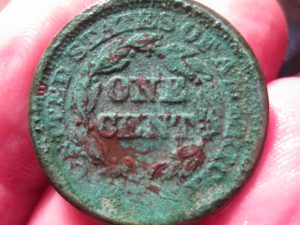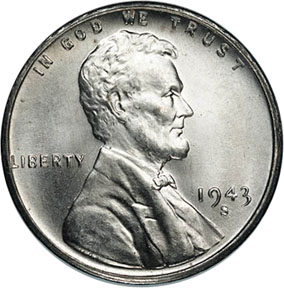Copper is the third most common element in the world.
Copper is a versatile metal that has been exploited for many purposes since the Bronze Age that started roughly in 3300 BCE. It is as practical as wire carrying electricity and for cooking. It is used for its artistic qualities such as the Statue of Liberty. Copper is also a medium of exchange.
Copper has a long history of being integrated with coins in the United States. From the first half and one cent coins of the late 18th century, every coin ever struck for circulation has contained copper, except for the 1943 Steel Cent.When coins were struck using precious metals, more were struck using a majority of the precious metal, and the balance was copper. Although legislation required changes in the composition of the alloy, copper continued to provide the filler.
Precious metals, like gold and silver, do not oxidize. Copper will naturally oxidize. Copper oxidizes when it is exposed to the environment. Water, salts, and acids in the air will react with the copper that will cause a molecular change in copper that causes its color to change. A typical example of what happens when copper oxidizes is the Statue of Liberty. The copper statue is now a blue-green color after many years of enduring the elements. That blue-green color is known as verdigris.
In numismatics, the copper oxidation is apparent as the colors of the half-cent, one cent, and two cent coins oxidize. When a coin is the color of the initially polished planchette, it is said to have a red color. As the copper in the coin oxidizes, the color is described as red-brown, sometimes with a percentage of red to brown color. A brown coin is a coin whose red color has completely oxidized.
The oxidation process is natural and can not be stopped. It is possible to slow the process. Eventually, the copper will oxidize and turn every cent ever struck to brown.

Would this metal detector find be considered “artificial toning” (Image from CTTodd.com)
As collectors, we have seen the natural oxidation of copper accelerated by artificial means. Coins stored in holders made of the synthetic polymer polyvinyl chloride (PVC) produce an acidic gas as it oxidizes accelerating the oxidation of the copper used to make coins. That acceleration can lead to the rapid breakdown of the PVC holder, causing it to appear as if it melted to coin. Numismatists call this damage. It is a natural reaction by the copper.
When copper oxidizes, it does not change its molecular structure but alters its form. If someone would test the surface of a cent with bright red color and one that has turned brown, both will test as being made of copper. The surface would have to examined on a molecular level to see how oxidation has reformatted the molecular structure.
Oxidation only changes the color on the surface. The Statue of Liberty is an example of this phenomenon. When the statue was conserved in the early 1980s, experts found that the verdigris covering the copper was no more than 6-8 millimeters (one-quarter of an inch) deep. As a testament to how copper can maintain its structure, it the restorers estimate that it had lost .01-percent of its surface in her 100 years of living in New York.Although few would call the verdigris on the Statue of Liberty ugly, verdigris on a coin causes people to turn their heads away.
Another way that the oxidation of copper changes coins is when a coin becomes toned. Some collectors marvel at colors some coins become when the copper in the alloy oxidizes. Others see the coin as damaged. Both views are right.
From a scientific perspective, a toned coin shows the flaws within the alloy. If the alloy was a consistent mixture of metals, toning on every coin would be similar. Instead, the inconsistencies of how the copper is mixed with the primary metal is revealed in the pattern of the toning. This inconsistency makes toning difficult to predict and challenging to detect whether toning was through natural oxidation or by artificial means.
Experts claim they can tell the difference between natural and artificial toning. With certain exceptions, such as the toning from known contaminants like the lignin in paper and PVC, very few people can tell the difference without extensive examination. Specialized equipment such as microscopes that enhance the image using a type of radiography is the only way to determine the difference between natural and artificial toning. And that is not a perfect solution.
The third-party grading services can examine coins using specialized equipment and determine whether the coin was naturally or artificially toned. But they can only be reasonably sure. Without examining the surface to determine the type of contaminants that caused the oxidation, they can provide the best guess based on the evidence they can collect.
If you read the various numismatic forums, members share many formulas that they found to accelerate the oxidation of the copper in a coin. Some have even bragged how they were able to have the coins graded by the third-party grading services as being naturally toned. Collectors continue to chase these coins and pay additional premiums for them.
Another numismatic curiosity is the alleged conserving of coins to remove damaging oxidation. Unlike the oxidation of iron, which breaks down the molecular bonds of the alloy, the bonds of oxidized copper molecules remain strong. The green color is on the surface of the copper where it was in contact with the contaminants.
It is impossible to reverse the oxidation of copper. The only way to remove the oxidized copper that has turned to verdigris is to remove that layer of copper. When speaking with professionals that restore art and antiques, they admit that their methods of restoring copper involve removing the oxidized layers. They recognize the fact that it is the only way to restore the luster to copper.
However, numismatic conservation services make claims that they can safely remove the oxidation without damaging the surface of the coin. When asking a professional art restoration company whether this was true, they wondered how these companies could get away with making their false claims.
When shown example images of coin conservation found online, the professionals were able to explain how most of the cleaning was done using sonic tools or high pressure distilled water possibly mixed with baking soda to raise the alkaline level of the water. They did refer to this as a form of cleaning because it is designed to loosen the bonds between the contaminants and the metals.
One set of images showed the removal of verdigris on a coin. The expert said that the only way to remove the verdigris spots was the alter the surface of the coin by removing that layer of copper which changes the surface of the coin. It is an evasive procedure, yet the example images showed the coin before conservation and following the work in a third-party grading service holder not marked as having altered surfaces.
While sitting at a table where a bronze bust worth tens of thousands of dollars was in the process of conservation, this expert saw before and after images of silver and gold coins and wondered if the numismatic industry knew something the multi-billion dollar art industry did not.
The art industry documents its conservation methods. Auction houses, insurance companies, dealers, and collectors know how art is conserved. They accept that the surface of the bust on the table is being altered to remove the verdigris spots. Once completed, the restored copper bust will be worth more to a collector, who will know about the restoration.Similar openness does not exist in the numismatic industry. Numismatic conservation companies do not document their methods by calling them trade secrets. These coins are in third-party grading service holders without any indication of their conservation, and the auction companies are happy to sell them for thousands or even hundreds of thousands of dollars.
What have we learned?
- Every coin that has been struck for circulation by the U.S. Mint contains copper except for the 1943 Steel Cent.
- Copper oxidized to the point of forming verdigris on the surface.
- Oxidation only occurs on the surface that is in contact with the environment.
- The rate of oxidation is controllable through proper handling.
- Once copper oxidizes, it is not reversible.
- It is not possible to remove oxidation without altering the copper surface.
The art world understands that conservation of copper requires altering the surface. It is accepted as part of an industry where significant works sell for tens- or hundreds-of-millions of dollars. The numismatic world hides behind alleged proprietary secrets and few questions about what they are doing.
Maybe it is time to ask the numismatic conservation companies to disclose what they are doing to understand whether they are altering the coins’ surface, or not. Maybe it is time to ask the third-party grading service why are they not disclosing that they are placing conserved coins in their holders. Maybe it is time to hold the auction companies and dealers responsible for not disclosing when a coin is conserved.
Maybe it is time the industry is honest with itself and honest with its collectors.





Great post. Thank you…
I am very impressed by your site and your post is very nice and I got such a piece of good information on this topic it’s a very interesting one.